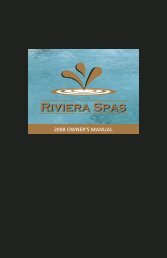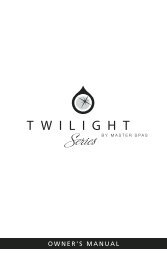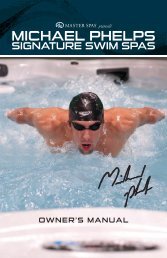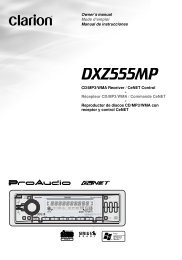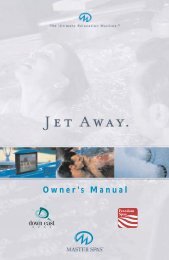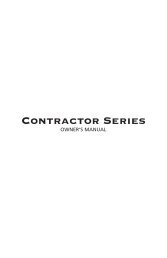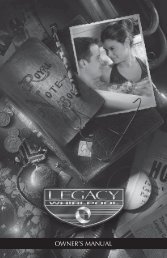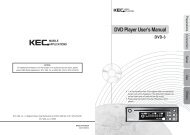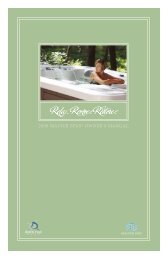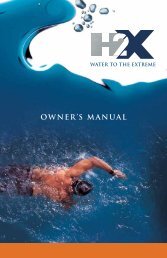2008 Therapool Owner's Manual - Master Spas
2008 Therapool Owner's Manual - Master Spas
2008 Therapool Owner's Manual - Master Spas
Create successful ePaper yourself
Turn your PDF publications into a flip-book with our unique Google optimized e-Paper software.
WATER CHEMISTRY TERMS YOU SHOULD KNOW<br />
Before jumping into the Spa Water Maintenance, here are some terms to help you.<br />
1. Parts per million, or ppm: This is a form of measurement used in most pool<br />
or spa chemical readings. Best described as any one million like items of equal<br />
size and make up, next to one unlike item , but of equal size. This would be<br />
one part per million.<br />
2. Average size spa: What is it? The national spa and pool institute (NSPI)<br />
states; 350 to 400 U.S. gallons is average. As a general rule, chemical dosages<br />
are the same for any spa between 100 and 500 U.S. gallons. <strong>Spas</strong> over 500<br />
U.S. gallons the dosage would be double. Under 100 U.S. gallons would be<br />
on a case by case basis.<br />
3. Total Alkalinity: This is a measurement of the ability of the water to resist<br />
changes in pH. Put another way, it is the water’s ability to maintain proper<br />
pH. Total alkalinity is measured in parts per million from 0 to 400 plus, with<br />
80 to 150 ppm being the best range for spas. With low alkalinity, the pH will<br />
flip, or change back and forth, and be hard to control. With high alkalinity it<br />
becomes extremely difficult to change the pH.<br />
4. pH or potential hydrogen: This is a measurement of the active acidity in the<br />
water, or it is the measurement of the concentration of active hydrogen ions<br />
in the water. The greater the concentration of active hydrogen ions, the<br />
lower the pH. pH is not measured in parts per million, but on a scale from<br />
0 to 14, with 7 being the neutral. In spas when ever possible, a measurement<br />
between 7.2 and 7.8 is best. Whenever possible, it should be between 7.4<br />
and 7.6. With low pH, the results can be corroded metals, etched and stained<br />
plaster, stained fiberglass or acrylic, eye / skin irritation, rapid chlorine or<br />
bromine loss, and total alkalinity destruction. With high pH, the results can<br />
be cloudy water, eye / skin irritation, scale formation and poor chlorine or<br />
bromine efficiency.<br />
5. Shocking: This is when you add either extra chlorine (superchlorinate)<br />
by raising the chlorine level above 8 ppm, or add a non-chlorine shock<br />
(potassium monoperoxysulfate or potassium monopersulfate) to burn off the<br />
chloramines or bromamines. A non-chlorine shock acts by releasing oxygen<br />
in the water, which serves the same function as chlorine. The advantage to<br />
using non-chlorine shock, is you can enter the water within 15 minutes after<br />
shocking. Using chlorine, you must wait until the total chlorine reading is<br />
below 5 ppm. One thing to remember, a non-chlorine shock will not kill<br />
bacteria or disinfect.<br />
6. Sequestering: This can be defined as the ability to form a chemical<br />
complex which remains in solution, despite the presence of a precipitating<br />
agent (i.e. calcium and metals). Common names for sequestering chemicals<br />
are; minquest, stain and scale control, metal-x, spa defender, spa metal<br />
gone, (etc.).<br />
17



